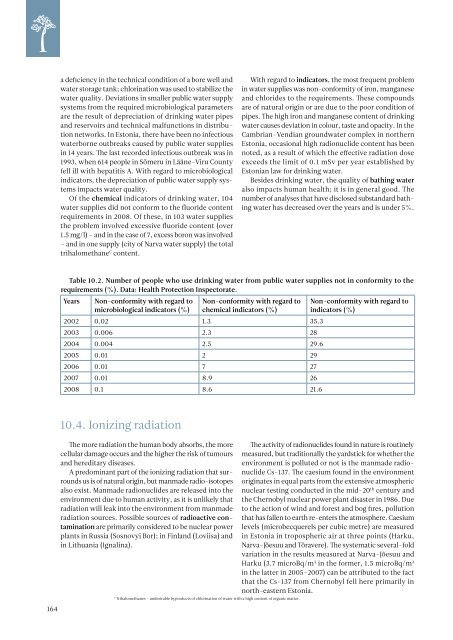ESTONIAN ENVIRONMENTAL REVIEW 2009
ESTONIAN ENVIRONMENTAL REVIEW 2009
ESTONIAN ENVIRONMENTAL REVIEW 2009
Create successful ePaper yourself
Turn your PDF publications into a flip-book with our unique Google optimized e-Paper software.
a deficiency in the technical condition of a bore well and<br />
water storage tank; chlorination was used to stabilize the<br />
water quality. Deviations in smaller public water supply<br />
systems from the required microbiological parameters<br />
are the result of depreciation of drinking water pipes<br />
and reservoirs and technical malfunctions in distribution<br />
networks. In Estonia, there have been no infectious<br />
waterborne outbreaks caused by public water supplies<br />
in 14 years. The last recorded infectious outbreak was in<br />
1993, when 614 people in Sõmeru in Lääne-Viru County<br />
fell ill with hepatitis A. With regard to microbiological<br />
indicators, the depreciation of public water supply systems<br />
impacts water quality.<br />
Of the chemical indicators of drinking water, 104<br />
water supplies did not conform to the fluoride content<br />
requirements in 2008. Of these, in 103 water supplies<br />
the problem involved excessive fluoride content (over<br />
1.5 mg/l) – and in the case of 7, excess boron was involved<br />
– and in one supply (city of Narva water supply) the total<br />
trihalomethane C content.<br />
With regard to indicators, the most frequent problem<br />
in water supplies was non-conformity of iron, manganese<br />
and chlorides to the requirements. These compounds<br />
are of natural origin or are due to the poor condition of<br />
pipes. The high iron and manganese content of drinking<br />
water causes deviation in colour, taste and opacity. In the<br />
Cambrian-Vendian groundwater complex in northern<br />
Estonia, occasional high radionuclide content has been<br />
noted, as a result of which the effective radiation dose<br />
exceeds the limit of 0.1 mSv per year established by<br />
Estonian law for drinking water.<br />
Besides drinking water, the quality of bathing water<br />
also impacts human health; it is in general good. The<br />
number of analyses that have disclosed substandard bathing<br />
water has decreased over the years and is under 5%.<br />
Table 10.2. Number of people who use drinking water from public water supplies not in conformity to the<br />
requirements (%). Data: Health Protection Inspectorate.<br />
Years<br />
Non-conformity with regard to<br />
microbiological indicators (%)<br />
Non-conformity with regard to<br />
chemical indicators (%)<br />
2002 0.02 1.3 35.3<br />
2003 0.006 2.3 28<br />
2004 0.004 2.5 29.6<br />
2005 0.01 2 29<br />
2006 0.01 7 27<br />
2007 0.01 8.9 26<br />
2008 0.1 8.6 21.6<br />
Non-conformity with regard to<br />
indicators (%)<br />
164<br />
10.4. Ionizing radiation<br />
The more radiation the human body absorbs, the more<br />
cellular damage occurs and the higher the risk of tumours<br />
and hereditary diseases.<br />
A predominant part of the ionizing radiation that surrounds<br />
us is of natural origin, but manmade radio-isotopes<br />
also exist. Manmade radionuclides are released into the<br />
environment due to human activity, as it is unlikely that<br />
radiation will leak into the environment from manmade<br />
radiation sources. Possible sources of radioactive contamination<br />
are primarily considered to be nuclear power<br />
plants in Russia (Sosnovyi Bor); in Finland (Loviisa) and<br />
in Lithuania (Ignalina).<br />
C<br />
Trihalomethanes – undesirable byproducts of chlorination of water with a high content of organic matter.<br />
The activity of radionuclides found in nature is routinely<br />
measured, but traditionally the yardstick for whether the<br />
environment is polluted or not is the manmade radionuclide<br />
Cs-137. The caesium found in the environment<br />
originates in equal parts from the extensive atmospheric<br />
nuclear testing conducted in the mid-20 th century and<br />
the Chernobyl nuclear power plant disaster in 1986. Due<br />
to the action of wind and forest and bog fires, pollution<br />
that has fallen to earth re-enters the atmosphere. Caesium<br />
levels (microbecquerels per cubic metre) are measured<br />
in Estonia in tropospheric air at three points (Harku,<br />
Narva-Jõesuu and Tõravere). The systematic several-fold<br />
variation in the results measured at Narva-Jõesuu and<br />
Harku (3.7 microBq/m 3 in the former, 1.5 microBq/m 3<br />
in the latter in 2005–2007) can be attributed to the fact<br />
that the Cs-137 from Chernobyl fell here primarily in<br />
north-eastern Estonia.

















